
Mushroom hunting, mushrooming, mushroom picking, mushroom foraging, and similar terms describe the activity of gathering mushrooms in the wild. This is typically done for culinary use, although medicinal and psychotropic uses are also known. This practice is popular throughout most of Europe, Australia, and Asia, as well as in the temperate regions of Canada and the United States.

Hypomyces lactifluorum, or the lobster mushroom, is a parasitic ascomycete fungus that grows on certain species of mushrooms, turning them a reddish orange color that resembles the outer shell of a cooked lobster. Contrary to its common name, the species itself is neither a mushroom nor a crustacean.

Panaeolus cinctulus, syn. Panaeolus subbalteatus, commonly known as the banded mottlegill, weed Panaeolus, belted panaeolus, or subbs is a very common, widely distributed psilocybin mushroom. According to American naturalist and mycologist David Arora, Panaeolus cinctulus is the most common psilocybin mushroom in California.
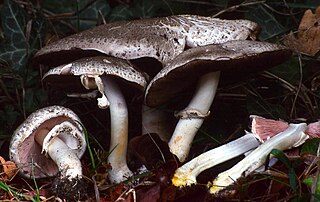
Agaricus moelleri, commonly known as the flat-top agaricus, inky mushroom, or dark scaled mushroom, is a large mushroom of the genus Agaricus. It appears occasionally in most kinds of woodland, during late summer, in northern temperate zones.

Calvatia booniana, commonly known as the western giant puffball, is a puffball mushroom that can grow 10 to 70 centimetres in diameter, as large as its close relative, the giant puffball of eastern North America and Europe. Like the giant puffball, it grows on composted soil such as in meadows, fields, and forests, as well as on roadsides, sagebrush flats, pastures, and other sunny places. In general, western giant puffballs occur on the west side of the Rockies and giant puffballs occur on the east side. However, on the West Coast of North America the western giant puffball is replaced by the giant puffball or a closely related species.

Rubroboletus pulcherrimus, known as Boletus pulcherrimus until 2015, and commonly known as the red-pored bolete, is a species of mushroom in the family Boletaceae. It is a large bolete from Western North America with distinguishing features that include a netted surface on the stem, a red to brown cap and stem color, and red pores that stain blue upon injury. Until 2005 this was the only bolete that has been implicated in the death of someone consuming it; a couple developed gastrointestinal symptoms in 1994 after eating this fungus with the husband succumbing. Autopsy revealed infarction of the midgut.

David Arora is an American mycologist, naturalist, and writer. He is the author of two popular books on mushroom identification, Mushrooms Demystified and All That the Rain Promises and More....

Panaeolus semiovatus var. semiovatus, also known as Panaeolus semiovatus and Anellaria separata, and commonly known as the shiny mottlegill, ringed panaeolus, common fungus of the feces variety, or egghead mottlegill, is a medium-sized buff-colored mushroom that grows on horse dung, and has black spores. Though nonpoisonous, it is generally regarded as inedible and possessing a rather abysmal taste, and a few people experience gastric upset after consumption.

Leucoagaricus leucothites, commonly known as the smooth parasol, woman on motorcycle, ma'am on motorcycle, white dapperling, or white agaricus mushroom, is a species of agaric fungus. The species was originally described as Agaricus leucothites by Carlo Vittadini in 1835, and bears similarity to species of that genus. Solomon Wasser transferred it to Leucoagaricus in 1977. While sometimes regarded as edible, the species is suspected of being poisonous due to gastric-upset-causing toxins. It could also be confused with the deadly Amanita ocreata.
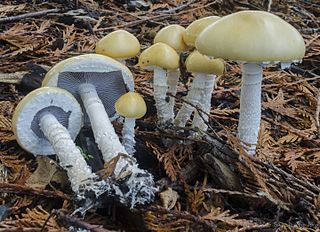
Stropharia ambigua, sometimes known as the questionable Stropharia, is a saprotrophic agaric mushroom, commonly fruiting in leaf litter and wood chips in the Pacific Northwest.

Mushrooms Demystified: A Comprehensive Guide to the Fleshy Fungi is a mushroom field and identification guide by American mycologist David Arora, published in 1979 and republished in 1986. All That the Rain Promises and More…: A Hip Pocket Guide to Western Mushrooms, a “field companion” to Mushrooms Demystified with cross references to that volume was published in 1991.

Polyozellus is a fungal genus in the family Thelephoraceae, a grouping of mushrooms known collectively as the leathery earthfans. Previously considered a monotypic genus, it now contains the Polyozellus multiplex species complex. The genus name is derived from the Greek poly meaning many, and oz, meaning branch. It is commonly known as the blue chanterelle, the clustered blue chanterelle, bluefan, or, in Alaska, the black chanterelle. The distinctive fruit body of this species comprises blue- to purple-colored clusters of vase- or spoon-shaped caps with veiny wrinkles on the undersurface that run down the length of the stem.

Crepidotus mollis, commonly known as the peeling oysterling, soft slipper, jelly crep, or flabby crepidotus, is a species of mushroom. Its edibility is unknown, but it is probably inedible and possibly poisonous.

Suillus tomentosus is a species of mushroom. The common names of the species are blue-staining slippery jack, poor man's slippery Jack, and woolly-capped suillus.

Amanita magniverrucata, commonly known as the pine cone amanita, or great pine jewel, is a species of agaric mushroom in the family Amanitaceae. First described scientifically by American mycologists Harry Delbert Thiers and Joseph Ammirati in 1982, it is mycorrhizal and associates with the tree Pinus radiata, which is commonly known as the Monterey pine.
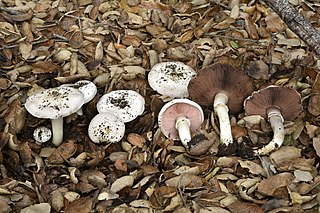
Agaricus californicus, commonly known as the mock meadow mushroom, or California agaricus, is a poisonous mushroom in the section Xanthodermati of the genus Agaricus.
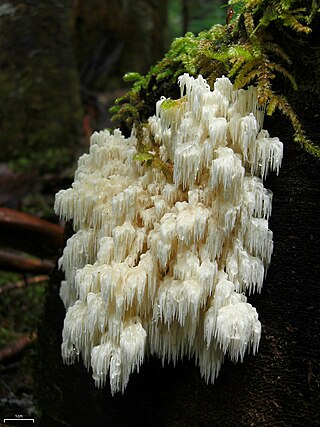
Hericium abietis, commonly known as the bear's head, conifer coral hericium, or western coral hedgehog, is an edible mushroom in the tooth fungus group. It grows on conifer stumps or logs in North America, producing a cream white fruit body up to 10–75 cm (4–30 in) tall and wide. It fruits from after the start of the fall rains to mid-season.
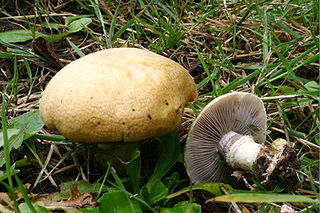
Stropharia coronilla, commonly known as the garland roundhead or garland stropharia, is a species of mushroom native to Europe and North America. It is considered poisonous, and is sometimes mistaken for species of Agaricus.

Polyporus tuberaster, commonly known as the tuberous polypore or stone fungus, is a species of fungus in the genus Polyporus. It is easily identified by the fact that it grows from a large sclerotium that can resemble buried wood or a potato.



















